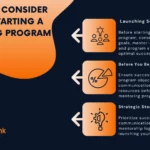
The meaning of life is connected to setting goals. In both academic and personal life, you can try to find your own way and it is possible by creating goals. In the world of personal development, leadership, and mentorship, having a structured and effective approach to goal-setting and problem-solving can make all the difference. Whether you are a coach, a mentor, a manager, or someone working on self-improvement, clarity is key. This is where the GROW Model enters the scene not just as a framework but as a transformative method that turns conversations into actionable progress.
What is the GROW Model?
The GROW Model is a popular coaching and mentoring framework that assists people in establishing specific objectives, examining their present circumstances, spotting potential roadblocks, and committing to concrete actions that will lead to success. Its name is an acronym for Goal, Reality, Obstacles (or Options), and Will (or Way Forward), each of which leads the person through a methodical dialogue that results in understanding and deliberate action.
Originally developed by coaching pioneers Sir John Whitmore and his colleagues in the 1980s, the model is grounded in the belief that people are more likely to achieve their goals when they feel ownership over their decisions.
Instead of offering direct advice, GROW invites the individual to reflect, evaluate, and articulate their own pathway forward. It’s a coaching conversation that fosters empowerment rather than dependency.
Used across corporate settings, educational institutions, and personal development circles, the GROW Model has become a go-to tool for anyone seeking to support others in clarifying their goals, overcoming barriers, and creating meaningful change. It is straightforward, easy to remember, and remarkably effective when applied consistently. Posing questions about your career or professional life is a part of GROW model. If you want to find good questions about your professional life, you can look our blog content “Questions About Career Development“
What Does the GROW Model Stand For?
A coaching framework known as the GROW Model facilitates structured discussions about achieving specific goals. It provides a road map for people and groups to move from where they are now to where they want to be in the future by methodically addressing important facets of achieving objectives.
Goal
Everything begins with the goal. In the first step of the GROW Model, the focus is on defining what the individual wants to achieve in their personal or professional life. A goal cannot be considered just about stating a vague desire but rather setting a clear, specific, and meaningful objective. A well-defined professional goal gives direction to the entire process. Questions in this stage might include, “What do you want to accomplish?” “What would success look like?” “When do you want to achieve it?”
Goals can be defined as short-term or long-term, but they need to be actionable and measurable in both styles. A strong goal sets the foundation for motivation, commitment, and forward movement. Without a well-articulated goal, the conversation may drift without producing tangible outcomes.
Reality
Once the goal is clear, it is time to ground the conversation in reality. The reality step is mostly about understanding where the individual currently stands in relation to their goal. It involves a realistic evaluation of the present situation, resources, challenges, and habits that are either helping or hindering progress.
This part of the model encourages honesty and self-reflection. It is about identifying facts, not opinions. What have you tried so far? What’s working, and what is not? What skills, knowledge, or support do you currently have? Understanding the gap between where you are and where you want to be is critical for developing effective strategies.
This stage frequently reveals unconscious patterns, presumptions, or limiting beliefs that haven’t been deliberately addressed. And it is only by fully acknowledging the present that one can plan for the future.
Obstacles and Options
After evaluating reality, the conversation shifts to exploring the obstacles that might get in the way and identifying various options for moving forward. This dual focus allows for creativity and problem-solving. Rather than becoming stuck in what is not working, this step opens the door to possibility and choice.
In this phase, the coach or mentor might ask, “What’s preventing you from reaching your goal?” “What could you do to overcome that challenge?” “What options have you not yet considered?”
Importantly, this is not about offering one “right” solution. It is about generating multiple paths and encouraging the individual to think flexibly. E
Exploring options allows people to weigh the pros and cons of each approach and select the one that feels most empowering and realistic.
Recognizing obstacles isn’t about dwelling on them but it is about demystifying them. When challenges are named, they become less intimidating and more manageable.
Will (or Way Forward)
The final step of the GROW Model is all about commitment. Once options have been explored, the individual must decide what actions they will take and when. This is the “Will” or “Way Forward” phase, where intention becomes action.
At this point, the coach or mentor might ask, “What specific steps will you take this week?” “How will you hold yourself accountable?” “What might get in the way of following through, and how will you handle it?”
The plan that is developed at this stage must be realistic, time-bound, and motivated by the individual receiving coaching. People are much more likely to follow through when they make their own decisions and lay out their own plans. That sense of ownership transforms insight into real-world results.
Benefits of Using the GROW Model
The GROW Model has gained popularity across coaching, leadership, and personal development due to its practical structure and impactful results. Benefits of the GROW model can be considered in different ways.
Clarity and Focus
One of the most prominent advantages of the GROW Model is its ability to bring clarity to complex situations. By encouraging individuals to define their goals with precision and assess their current reality, the model provides a roadmap from present challenges to future outcomes.
This procedure provides a clear path and helps to remove confusion. A strong sense of focus is produced by knowing exactly what you want to accomplish and the steps necessary to get there, which increases commitment and motivation.
Enhanced Decision-Making
The model’s structured inquiry into options pushes individuals to think critically rather than react impulsively. During the “Options” part, people explore multiple possibilities, evaluate potential risks and rewards, and select paths that best align with their long-term goals. This practice not only improves strategic thinking but also builds better decision-making habits over time. People become more comfortable weighing alternatives and making thoughtful, informed choices.
Accountability and Commitment
In the “Will” phase of the GROW model, people tend to establish clear action plans and commit to timelines. This aspect of the model transforms goal-setting from a passive activity into a results-driven practice. When individuals articulate specific actions and agree to deadlines, they inherently take on more responsibility. This inherent accountability facilitates continuous momentum and facilitates progress monitoring. Whether applied in personal goal setting or team performance reviews, this accountability boosts consistency and reliability.
Flexibility and Adaptability
The simplicity of the GROW Model contributes significantly to its versatility. Because it does not rely on industry-specific jargon or require technical training, it can be easily applied in various contexts from executive coaching and project management to student development and one-on-one mentoring.
Its four-phase structure remains effective regardless of the goal’s size or complexity, making it a universal framework that serves diverse industries and individuals.
Empowerment Through Self-Discovery
Perhaps the most transformational benefit of the GROW Model is how it empowers individuals. Rather than giving direct advice or imposing solutions, the model facilitates self-directed reflection. People can discover their own solutions through guided questions, which fosters a greater sense of ownership.
This process promotes autonomous problem-solving skills, strengthens critical thinking, and increases self-confidence. As individuals gain more experience navigating this structure, they become better equipped to lead themselves in terms of professional and personal growth.
How the GROW Model Helps Mentorship?
Mentorship, at its heart, is about helping someone uncover their potential not by handing out answers, but by guiding them to discover their own path. This is precisely where the GROW Model proves invaluable. It brings structure to the mentoring process, turning it into a thoughtful, empowering journey that fosters both confidence and direction.
Within a mentoring relationship, the GROW Model serves as a shared roadmap. Instead of vague advice, it steers conversations toward specific goals, real-world challenges, and practical steps. The relationship with your mentor should rely on good questions. If you ask right questions to your mentor you can benefit much from this process. Our blog content about ” Icebreaker Mentoring Questions” can help you in this case.
Because the model balances independence and guidance, it is aesthetically pleasing. Through open-ended questions rather than quick fixes, mentors encourage mentees to think critically and make decisions.
This approach can be considered essential because mentorship should build capability, not dependence. With GROW, mentees gain tools to define their goals, navigate setbacks, measure their own progress, and take ownership of their growth.
What is more, it allows for progress to be seen over time. Previous goals can be revisited, achievements recognized, and lessons reflected on. This ongoing feedback loop brings a sense of movement and meaning that keeps both mentor and mentee engaged.


